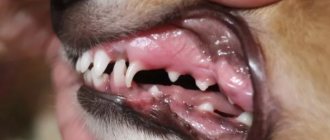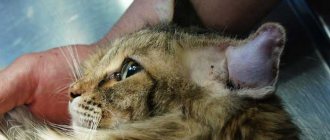Author: Vyugina Oksana Valerievna, veterinary dermatologist, allergist, cytologist, veterinary clinic “Solnyshko” Kazan
Every cat and dog owner has heard of ear mites. Many of you may have already treated your pet for ear scabies (otodectosis) and in some animals, for some reason, after some time it comes back again and again, causing discomfort to both our pet and you. Let's try to figure out this issue together and find out why we often hear about ear mites in cats.
So, ear mites in cats really love to live in the ear canals of cats, and much less often we can find this parasite in dogs; it can also infect the ears of ferrets, rabbits, and foxes. Who is he and what does an ear mite look like? Its name is Otodectes cynotis, we call it Otodectes and it is very contagious (infectious) (photo1).
Photo 1.
This mite is an external parasite (that is, it crawls along the surface of the skin, ear canals, without penetrating the skin), it is quite large and, if you have a magnifying glass at home or excellent vision, you can look into the ear and see how white-gray grains are actively moving (photo 2 tick under a magnifying glass).
Photo 2. Ear mites under a magnifying glass
Ticks have 8 legs, 4 on each side, and females are slightly longer than males. The female lays eggs, the larva hatches from the egg, it differs from adults only in that it has 6 legs, 3 on each side. After some time, she matures (molts) and becomes an adult with 8 legs. And this period of time from egg to adult passes in 18 - 28 days. You may say, why do we need to know all this? Yes, everything is simple, so you can determine when the disease occurred. You ask how? Everything is very simple. For example, you went to the dacha, an infection occurred there, and from the moment of infection to complaints from your pet, about a month will pass, when the ticks will have time to multiply (there will be more of them) and will be more disturbing to the animal. This way you will understand where and when the infection occurred. You also need to take into account that ear mites in cats can be on any surface of the skin. Yes, of course, in 80% of cases it is located in the ear canal, because... there he lays eggs, but nothing prevents the adult from moving around the animal’s body. Very often it can be found on the head and even the croup (lower back, near the tail), tail, neck, between the toes (photo 3).
Photo 3.
Where can you get infected?
Let's now look at where a cat can become infected with this mite.
- Option #1. If you bought a kitten, and it complains about its ears, then in this case the infection occurred from its mother, the cat.
- Option #2. If your pet left the house, even for 5 minutes. He went out to the entrance, went to the dacha, exhibition, mating, etc.
- Option #3. You picked up a stray animal and brought it home for a while, even for 5 minutes, and you already have a cat. This is also enough for your pet to receive a portion of ticks.
- Option number 4. There are 2 cats living in the house, one has constant problems with her ears, and the other is fine. This suggests that there is a hidden carrier in your family, i.e. He doesn’t get sick himself, but he constantly infects others. Can you guess who it is? Yes, it is the cat that does not complain about its ears that is the hidden carrier of the tick.
Ear mites: what is it, where does it come from and why is it dangerous?
Ear mites are small parasites - Otodectes cynotis, localized in the external auditory canal of the animal and feeding on particles of the epidermis, blood and lymph. Their body is colored light yellow, has an elongated oval shape and does not exceed 0.6 mm in length. The vital activity of the parasite leads to injury to the sensitive surface of the inner part of the ear and contributes to the development of otodectosis, or ear scabies - a serious invasive pathology, accompanied in most cases by a bacterial infection. Severe advanced forms of otodectosis can lead to the death of the animal.
This is what an ear mite looks like under a microscope
Both dogs and cats can become infected with ear mites, but otodectosis is more common in representatives of the cat family. Ear mites are usually not dangerous to humans. People can carry the parasite and infect their pet.
How does infection occur?
There are several options for where ear mites come from. Animals that regularly walk outside suffer the most from parasite attacks. Not only ticks, but also other dangerous parasites lie in wait for them in the grass or garbage, in basements and attics. A healthy pet can become infected after contact with a sick animal, through care items - a comb, a carrier, etc. Owners are surprised when a tick appears on a pet that does not go outside. In this case, the culprit of the infection is the person himself - the parasite can be brought into the room on shoes, clothes, or hands. Often ticks are carried by flies or fleas.
Otodectosis is characterized by seasonality. In most cases, infection occurs during warm weather, which is favorable for the parasite. Outside the animal's body, Otodectes cynotis can exist for up to two months. If during this time the parasite does not find a host, it will die. Ear scabies most often affects pets under one year of age. Adults become infected from sick animals or when their immunity is weakened.
Why are ear mites dangerous?
Ear mites themselves are not dangerous and require simple therapy. But if left untreated, the disease can lead to serious consequences:
- intensive scratching will cause damage to blood vessels, which will lead to the formation of a hematoma;
- the skin of the inner surface of the ear will swell and become inflamed, and the pet will develop otitis media;
- the animal will gradually lose hearing;
- possible damage to the eardrum will cause inflammation of the middle and inner parts of the ear, which will ultimately lead to inflammation of the meninges and death of the animal.
On the left is the initial stage of ear mite infection, on the right is a very advanced case
Otodectosis in cats, what are the symptoms?
As we discussed above, clinical signs in some cats may be asymptomatic, but most often cats experience severe itching and otitis externa. Since the mite is very active in the ear canal, it causes severe mechanical irritation, which leads to characteristic signs of the disease. Signs include scratching on the ear flaps, inflammation of the ear canals, and a buildup of copious amounts of wax that initially resembles “coffee grounds” and then, if a secondary infection (bacteria) develops, a purulent discharge from the ear. And almost always, due to itching, the animal constantly shakes its head. The severity of clinical signs is strictly individual. It may be that the cat has severe irritation, with a lot of dark discharge, even blood in the ear canal, but there are few mites there. Others' ears may look almost clean, but there are a lot of mites there. In some cats, the ear canal may be filled with dry, scaly discharge. It is not uncommon for cats to develop a hematoma of the auricle due to severe itching and, as a result, trauma to the auricle. We also remember that mites can leave the ear canal and cause lesions in the head and other parts of the body, where miliary dermatitis (small sores on the body or in a certain area) very often develops.
Ear scabies in cats and cats
Ear mites are parasitic arthropods that can only be seen with a microscope, otoscope or magnifying glass. This infection has an internal (Otodectes cynotis) and external (Notoedres cati) form, causing inflammation, unbearable itching, and pain. A cat, scratching its ears, damages the skin with its claws. Then an infection joins the open wound, causing serious complications and purulent inflammation. Blood or lymphatic vessels are often injured.
In areas where blood vessels are damaged, blood leaks under the skin and hematomas are formed, for the treatment of which surgical methods are used. A conservative treatment method is used if the lymphatic vessel is damaged and lymph accumulates under the skin. Then the contents are pumped out with a syringe, and the medicine is injected into the cavity using the same instrument. But since it is very difficult to stop the flow of lymph from a damaged vessel, the conservative method is not always effective, and then the doctor has to resort to surgery.
Outside the animal's body, under favorable conditions (warm room with high humidity), ticks remain viable for 3 weeks to 2 months.
Diagnostics
Diagnosis of otodectosis in cats. As mentioned above, the tick is quite large and can be seen when magnified with a magnifying glass. But you still need to contact a veterinarian to confirm that otitis media is actually caused by an ear mite (since there are many causes of otitis media in animals) and to make sure that there are no complications in the form of the development of a secondary infection (bacteria). At the appointment, the doctor will collect an anamnesis, perform an otoscopy (examination of the ear canal) - during this procedure, a tick is detected in 50% of cases, the doctor must also take a smear from the ear to check for otodectosis and cytology (stained smear) to check for bacteria.
Symptoms of infection
The symptoms that you need to pay attention to first in order to promptly detect otodectosis in a cat or kitten include:
- the appearance of redness and peeling of the inner surface of the ear;
- restless behavior of the animal - due to annoying itching, the cat shakes its head and constantly scratches its ears;
- release of fluid - exudate;
- the appearance of bald patches and areas with glued hairs in the lower part of the ear;
- the formation of dark brown scabs;
- unpleasant odor due to accumulations of pus;
- crooked head - in complicated forms of infection, the animal tilts its head towards the affected ear.
The owner should keep in mind that the consequences of a seemingly harmless pathology in the absence of therapy can be disastrous.
Treatment of ear mites in cats
How to treat ear mites in cats. There are many drops on the market today, so how do you choose the right one? Ideally, your veterinarian should choose the best option for your pet, and if there is a complication in the form of otitis media, prescribe additional treatment. But what should you pay attention to when choosing a medicine for ear mites in cats:
- safety, the drug should not harm the animal’s body; /li>
- efficiency, a systemic effect is necessary, because we remember that ticks can parasitize not only in the ears, but also on the surface of the body;
- ease of use, application of the drug should not cause stress to the animal;
- It is important to treat all animals in the house! For example, if 2 cats live in a house together, then we process both, 5 cats together - we process five, and so on, if a cat and a dog live together, then we process both.
Following from the above, local drops in the ears are not the best option for treating otodectosis, because it is painful (severely stings and irritates the ear canal), there is no systemic effect (while you are dripping into your ears, the mite will safely wait out this process on the croup or neck, and then return to the ears), i.e. the risk of relapse (recurrence of the disease) is very high. Well, if you have several animals and they all need to put drops in their ears, then this is a very labor-intensive process that takes a lot of time. Therefore, today the most effective way to treat ear mites in cats is considered to be drops on the withers, which destroy not only otodectosis, but also other parasites, including fleas.
One of these drugs is Stronghodl, let's see what its advantages are. Stronghold is an antiparasitic drop on the withers containing selamectin. It is active against: scabies mites (sarcoptosis), otodectosis in cats and kittens, fleas, lice, lice, as well as heartworms (internal parasites living in blood vessels and the heart) and intestinal roundworms. It is easy to use, applied to the skin in the withers area once a month, the volume of drops is very small (does not spread over the skin), is quickly absorbed and begins its work against parasites in full force within 12 hours after application and retains it for a whole month. It is important that Stronghold can be used in the smallest pets (kittens, puppies), it is well tolerated by the baby’s body and protects them from parasites. Let's say you decide to buy a kitten, you have already bought bowls, toilet, food, beds at the pet store, but do not forget to buy Stronghold. On the same day, as soon as you bring a new resident, put drops on his skin between the shoulder blades, thereby ensuring the prevention of most parasitic diseases that can be dangerous for babies at this early age. Important! If you still want to give your kitten a complex deworming tablet, it is better to consult a doctor, since some drugs are best given at intervals of a week after applying Stronghold.
Sarcoptoid ear mite Notoedres cati
The sarcoptoid mite Notoedres cati causes a disease called notoedrosis . This parasite takes root on the outside of the animal's ear, at its base. The size of this mite is 0.14-0.45 mm. The body is transparent, spherical in shape. In humans, this mite can cause pseudoscabies, which is manifested by itching and an allergic reaction to the bites of the parasite.
Notoedres cati mite under a microscope
When the Notoedres cati tick gets on the skin of pets, it gnaws through it and penetrates under the epidermis. There he makes deep passages, and the females also lay eggs in them. The waste products of the parasite also accumulate here, which have a detrimental effect on the cat’s body and lead to the occurrence of infectious, fungal and bacterial diseases. This type of mite can pass to humans , but it is not capable of developing and multiplying on human skin, so there will be no serious consequences.
Prevention of otodectosis
Measures to prevent otodectosis:
- preventive treatment with acaricidal drugs, which are often included in drugs that prevent the appearance of fleas;
- preventing cat contact with stray animals;
- regular monitoring of the condition of the cat’s ears;
- when introducing a new pet, especially one taken from the street, into an established cat community, you need to make sure that it does not have otodectosis;
- regular wet cleaning of the premises where cats are kept;
- steam treatment of beds and soft toys, regular washing of bedding;
- avoiding overcrowding when keeping cats.
If one of the cats living in the house becomes ill with otodectosis, then all pets must be treated, since otodectosis is a highly contagious disease.
How can a pet become infected?
A cat can pick up ear mites on the street, through contact with sick animals or in walking areas. Most stray cats suffer from otodecosis, so letting your pet roam freely is fraught with negative consequences.
The parasite can be picked up on shoes by the owner while accidentally walking in places where stray cats like to gather. An owner can bring ear mites home after petting someone else's pet with otodecosis. In addition, there is a high probability of disease in homes where there have already been (or are) cases of the disease in other animals.
Kittens can become infected at birth from a mother who is a carrier of ear mites. Infection through bedding, carpets, household furniture or dishes is possible.
Possible complications of otodectosis
Complications of otodectosis include:
- bacterial or fungal otitis - are the most common complications of otodectosis;
- hematomas and lymphatic extravasations of the auricle are also common, are the result of self-harm and require the participation of a veterinarian. Hematomas are formed when a blood vessel is damaged, lymphatic extravasates - when a lymphatic vessel is damaged by a cat’s claws. In this case, an accumulation of blood or lymph occurs in the tissues of the ear, which requires opening and draining the resulting cavity with evacuation of its contents. Otherwise, suppuration will occur, which will result in permanent scar deformation of the ear. The opening and drainage of the hematoma or lymphatic extravasation is performed by a veterinarian;
- miliary dermatitis (eczema) - develops in some cats because mite saliva and feces are strong allergens. At the same time, numerous bubbles appear in the ear area, which, when opened, turn into erosions covered with dry crusts. This increases inflammation, pain and skin itching, significantly worsening the cat’s condition;
- perforation of the eardrum and the development of otitis media and internal otitis: leads to decreased hearing up to its complete loss, but with a small hole size and proper treatment, the membrane is quickly restored;
- leads to the appearance of peripheral vestibulopathy, while: the coordination of movements in the cat is impaired;
- Characteristic is a lateral tilt of the head, the affected ear facing downwards;
- the cat can move in a circle;
- Nausea may occur when moving;
- strabismus occurs.
- extremely serious condition of the cat;
Ear hematoma often occurs during otodectosis as a result of self-injury; opening and emptying of hematomas is carried out by a doctor in a veterinary clinic
Diagnosis of otodectosis
To make a diagnosis, the veterinarian examines the cat and asks the owner about the onset and development of the disease. Additional research methods are carried out to verify the diagnosis and, if necessary, to clarify the extent of the process:
- microscopy of earwax and scrapings from the ear is performed. Under a microscope, living mites at different stages of development are visible, and you can also determine the type of secondary flora that has attached;
- bacteriological examination - if necessary, to accurately identify the secondary flora, cultures are carried out on nutrient media;
- otoscopy - performed to assess the condition of the external auditory canal and eardrum. In case of severe inflammation of the external auditory canal, otoscopy is abstained until the inflammation decreases;
- computed tomography or magnetic resonance imaging - performed when the infectious process spreads to the middle ear, inner ear, or meninges.
To more accurately assess the distal part of the external auditory canal, as well as the eardrum, veterinarians perform otoscopy
Folk remedies for ear mites
Folk remedies are recommended to be used only at the initial stage of infection, for prevention or as an auxiliary method of treatment. To cleanse the inner surface of the ear from crusts and scabs, you can use regular sunflower oil, as well as camphor or vaseline oil. For processing you will need cotton pads. Excess oil should be blotted off.
For disinfection purposes, you can use a 3% hydrogen peroxide solution. A cotton pad should only be slightly moistened with the product and gently wipe the infected area with it. In this case, you need to make sure that the peroxide does not flow deep into it.
A strong infusion of green tea is suitable as an antiseptic - a dessert spoon in half a glass of boiling water. Wipe the ears with a warm solution using a cotton pad.
Garlic is an excellent antiseptic, but it cannot be used in its pure form to treat your pet’s ears - it can provoke even greater irritation of the problem area. In the complex treatment of otodectosis, you can use a mixture of 2 tbsp. l. vegetable oil and half a chopped garlic clove. The composition is kept for a day in a dark and warm place, and then filtered.
If there are several pets living in the house, you need to protect them from contact with a sick animal, and also treat them for prevention.
Routes of infection
Infection with ear mites most often occurs from a stray sick animal. That is, a pet can get sick from a cat that is a carrier of the disease. During infection, the animal usually has a weak immune system.
Possible routes of infection:
- pet care items (comb, carrier, clothes);
- owner's clothes and shoes;
- fleas, flies;
- wild animals (foxes, raccoons).
Either the tick itself or its eggs get on the cat's skin or fur. First of all, the parasite penetrates the ear, injuring the skin. The waste products of arthropods lead to inflammation and pain in the pet. Afterwards, swelling of the blood vessels develops. The ear swells, exudate separates, which after drying turns into brown crusts. Subsequently, the layering of crusts forms plugs. If left untreated, the pressure of the plugs on the eardrum can cause it to rupture. Unfortunately, there is no vaccination against ticks.
Treatment and diagnosis
Unlike other diseases, the diagnosis of otodectosis is not difficult to make. Clinical symptoms and laboratory tests allow this to be done quickly and accurately. Ear scabies can be distinguished from other parasitic diseases by the predominant damage to the ears of the sick animal. The veterinarian will make or rule out this diagnosis thanks to professional taking and examination of scrapings under a microscope .
As for treatment, there are two approaches and both have been used successfully.
External treatment - applying liniments, drops and ointments to the skin at the affected area.
Internally - in the form of subcutaneous injections with acaricidal drugs. They are often combined in severe cases of illness, which allows the cat to be cured faster.
Before applying the medicine
, the ear must be washed and cleaned of waste products of mites, crusts, and scabs. This is done using hydrogen peroxide, furatsilin or a special veterinary solution. It is advisable to do this with an assistant or with the cat swaddled so that it does not hurt you.
If you follow the treatment regimen, depending on the severity of the disease, in two to three weeks you can rid your cat of all symptoms of ear mites .
Remember that among all cats admitted to veterinarians with a primary diagnosis of otitis media, the overwhelming majority are also diagnosed with otodectosis, which caused ear inflammation. The favorite target of the disease is a kitten from one to four months. There have been cases when a baby was purchased that was already infected with a tick. Therefore, be attentive to any changes in your pet’s well-being and behavior.
As soon as your cat begins to itch, become restless, or lose appetite, contact your veterinarian. He will help you make a diagnosis, prescribe treatment and accompany your pet until full recovery. In our store, you will not only receive the help of a qualified veterinary dermatologist, but you will also be able to purchase medications at low prices thanks to direct purchases from the manufacturer. Treatment supervision by a veterinarian is the key to successful treatment for your pet! And don’t let otodectosis in cats bother your pet.
If you find an error, please select a piece of text and press Ctrl+Enter.
Treatment of a kitten or pregnant cat
The insidiousness of the disease is that otodectosis often occurs in kittens. But, judging by the statistics, animals of any gender and age get sick. Whether it is a small kitten, a pregnant cat or an adult cat, the disease makes no difference.
Kittens can become infected with otodectosis from their mother.
In case of pregnancy or young age, drugs are used to treat otodectosis in cats, which are prescribed in the instructions for use.











